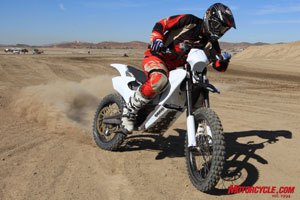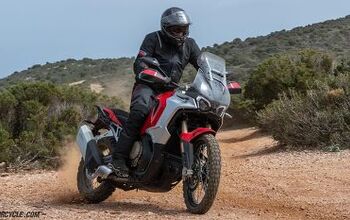2010 Zero MX Review - Motorcycle.com
Get the Flash Player to see this player.
That first effort was basically a powered mountain bike, well-suited to trail use. It opened up a lot of terrain that was closed to gas-powered bikes and promised to make a great little play bike, too. Our tester (ex-AMA champ Micky Dymond) rode it at a mini-bike track and quickly found its limits by shattering the rear shock.
We're pleased to report that the new, heavier-duty MX model survived this year's test even though Micky rode it at Lake Elsinore — a full-on moto track where he landed some much bigger jumps. “It feels way more solid,” Micky told us, “so I have a lot more confidence to jump stuff.”
On the face of it, that pretty much defines the new bike as a success. Zero's Neal Saiki told MO, “We got a lot of feedback from buyers, that they wanted to be able to get some air — not that they necessarily wanted to tackle real motocross tracks — but that customers wanted to have a little track in their backyard and land some jumps.” At a time when it's getting harder and harder to find open terrain, the idea of bike so quiet you could practice in any vacant suburban lot definitely has some appeal.
Compared to the basic X model, the MX features a heavier duty shock and fork, bigger tires on wider rims, and stronger hubs. Those changes make it about 10 pounds heavier and give it much-improved moto capability. Ironically, those changes also allowed our tester to spend more time at full throttle, which highlighted the bike's Achilles heel: battery life.
That battery is a two kilowatt-hour lithium-ion array. It weighs about 45 pounds, and is set up for a rapid swap. The idea is that customers can buy an extra battery, and have one on the charger and one on the bike, or bring a spare with them to the track (in the same way you'd bring extra fuel for your gasoline-powered bike.) Changing batteries is no harder than refueling; no tools are required.
Battery charge is indicated by an LED array. As charge drops, the rider hears a warning beep, too. At that point, the bike will still cover few miles at slow speed, but the onboard computer/controller will actually cut power if you attempt to use full throttle. Pay attention to that LED and beep, or risk the consequences when the bike cuts power on the face of a double jump!
The X and MX use the same brushed DC electric motors. Buyers of either bike have the choice of two motors, one of which is about 10% more powerful. Zero claim 23 horsepower and 50 foot-pounds of peak torque for the standard MARS motor. That's plenty for such a lightweight bike, and at least off the bottom the claim seems to be justified, especially because electric motors make peak torque as soon as they start to spin.
The power output of electric motors is strictly a function of voltage. The Zero system operates at 58 peak volts. “You could lick your fingers and bridge the two poles of our battery, and it wouldn't hurt you,” Saiki told us (but we didn't ask him to demonstrate!).
The Zero motors rev to about 2,500 rpm, and like all DC motors, there's a linear fall-off of torque beginning at about half peak revs. So the overall impression is of a motor that pulls hard off the bottom and quickly runs out of power. A transmission would allow the rider to keep the motor in the torque band, but would add weight and mechanical drag.
Since there are no gears, and thus no need for a clutch, Zero off-road bikes are set up like bicycles, with two hand brakes. There are no foot controls at all. The 'throttle,' which is actually more like a rheostat, can't be directly wired to the motor; doing that would make it almost impossible not to wheelie the bike over backwards. Instead, the motor's controlled by software that ramps torque up gradually.
Getting that motor control software right is the equivalent, on an electric motorcycle, of sorting out the throttle response on a fuel-injected bike. “I find that I'm dragging the rear brake a lot,” Micky said, “even when I'm on the throttle, to stabilize the bike in mid-corner.” He also noted the complete lack of engine braking, but told us he quickly got used to it.
“You can't just slam it in to loose, heavy dirt,” Micky added, “it skates over that stuff like a bicycle. That's harder when there's ruts and berms. But on some of the drier stuff, that light feel is awesome. On a real technical, dry, slippery track, with lots of corners and few jumps, these things would be pretty quick.”
Then, under his breath, we heard him say, “I want one of these things.”
Overall, Micky found the base model MX to be a dramatic improvement on the original X, and the optional suspension package to be even better still. The top-level suspension was so much better that he spent more time at full throttle. That highlighted a problem; although Zero claims anywhere from 45 minutes to two hours of battery life, our expert tester never got more than 30 minutes in before losing full power.
So, where does that leave potential customers for this bike, besides occasionally stranded? Does it make having a spare battery essential for anything more than short sessions in your own backyard?
The Zero MX base model sells for (are you sitting down?) $8,250. The 'Extreme' option package, which includes stiffer Marzocchi fork and FastAce shock, and the slightly more powerful German-made PERM motor is an extra $1,700. A spare battery is $2,950. Call it anywhere from nearly double to nearly triple the price of, say, a Honda CRF150R.
We asked Neal Saiki if, as with other high-tech products, we could expect exponentially increasing performance and decreasing prices. He told us that battery costs aren't dropping, presumably because there are lots of new EV companies coming on the market, driving demand, and only a handful of companies make Li-ion cells. So far, Zero's prices have held more or less steady.
That cost might be justified if there's a vacant lot in your neighborhood where a gas-powered bike would draw the ire of neighbors and the attention of the Sheriff, but you could ride the nearly-silent Zero MX.
Realistically, if you plan on trucking/trailering your bike to a practice area, the total carbon footprint of your outing is high either way, and for the foreseeable future, the satisfaction of going green will come at high cost.
One thing's certain, though, zero-emission bikes are getting more fun by leaps and bounds.
| Zero Specs | |||
| X | MX 'Sport' | MX 'Extreme' | |
| Permanent brushed motor | MARS | MARS | PERM |
| Horsepower | 23 | 23 | approx. 25 |
| Torque | 50 ft-lbs | 50 ft-lbs | approx. 55 |
| Battery range | 2 hours/40 mi. | ||
| Recharge time | |||
| Fork Travel | 8” | 8” | 8” (Marzocchi) |
| Shock travel | 9” | 9” | 9” |
| Front tire | 20 X 3.0 | 19 X 3.0 | 19 X 3.0 |
| Rear tire | 17 X 3.5 | 17 X 3.5 | 17 X 3.5 |
| Weight | 151 pounds | 156 pounds | N/A |
| Price | $7,450 | $8,250 | $9,950 |
More by Mark Gardiner


































Comments
Join the conversation